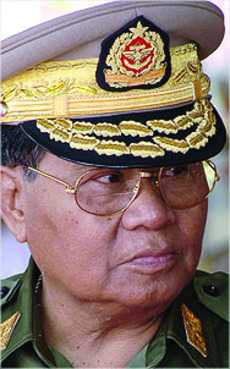It looked like revolution. Tens of thousands of Burmese anti-military protestors, including thousands of saffron-robed Buddhist monks, marched across the world’s television screens this fall, throwing light onto a repressed and impoverished nation usually relegated to the periphery of the world stage.
But the protestors who so recently crowded the streets of Myanmar’s cities, demanding the military junta’s downfall, have ominously vanished, replaced by staged pro-junta rallies, where it is rumored that cash incentives and force guarantee attendance.
Things seem to be returning to what passes for normal in Myanmar, a country of about 50 million people, where the vast majority of the population lives on about 50 cents a day.
The “Saffron Revolution” began when the junta raised fuel prices by two-thirds in mid-August, further restricting the ability of the Myanmar citizens to obtain food. On Sept. 5, several monks were wounded when a peaceful protest was suppressed by the government. The following day monks briefly held a few government officials hostage and demanded an apology before Sept. 17.
With no apology forthcoming, thousands of monks streamed into the streets. The laypeople, who had originally stayed at home, lined the path of the monk’s protest march, to protect them from government security forces.
Protests increased in size and intensity throughout September, led in many cases by the monks who, until recently, were one of the only non-government groups allowed to congregate in groups of more than three.
Myanmar is a devout Theravadian Buddhist nation, and monks are a highly respected part of everyday life. The monastic support for and mass participation in protests shook the junta, and there were fears that army units would refuse to fire on monks.
“Buddhist monks are not supposed to make their own food; they rely on others,” said former Assistant Professor of Religious Studies and Peace and Conflict Studies Shelini Harris in a panel held by the international studies department in response to the crisis. “If you are not worthy . they turn their bowl upside-down. They are no longer accepting donations from people in the government. They turn their bowls upside down. It’s akin to the Catholic notion of excommunication.”
The popularity of the monk-led protests led many foreign observers to predict the government’s imminent collapse. But even at the height of the protests, the Myanmar population was not as ready to proclaim victory as were Western observers.
“No one … believed the government would yield; they were marching less in hope than in anger and despair,” the Economist reported in September.
On Sept. 26, the government began to crack down on dissenters, raiding monasteries and arresting, beating, and shooting protestors. Many were killed, including a Japanese photojournalist filming a confrontation between security forces and protestors, who was knocked over and shot to death at point blank range by a government soldier.
“Myanmar is a terribly repressive place and the government isn’t about to relinquish their power,” said Assistant Professor of Religious Studies Eric Mortensen. “The government says 10 people were killed (in the crackdown). Trustworthy sources say it was at least 200. And 10,000 people were rounded up, including many of the monks. Twelve monasteries around Rangoon have been raided and we don’t know where the monks are. And that is terrifying.”
The government crackdown has targeted the monks specifically. Thousands of monks are unaccounted for and many monasteries are empty or barricaded by security forces. Although some military leaders resisted violent acts against monks, many have not.
“There were secret codes to start shooting (monks). If I had stayed on I would have to follow these orders,” said Major Hla Lin, who fled the country before he could be made to order killings, according to Telegraph UK. “I am a Buddhist and I did not want to carry out these orders.”
The government crackdown this fall seems to have been effective. The last of the major leaders of the “Saffron Revolution” were apprehended on Oct. 13 after the UN issued a statement strongly condemning the violent suppression of the protests.
“Most shops and temples have reopened and people appear to be getting on with their lives,” the BBC reported. “But there seemed to be a group of soldiers around every corner, and very few monks about.”
On Oct. 20, the government removed curfew orders on Yangon and Mandalay, the two largest cities in the country.
According to BBC News, The White House issued a statement calling the retraction of the curfew order a “bad sign” because it meant the military felt that they had successfully repressed the protests.

